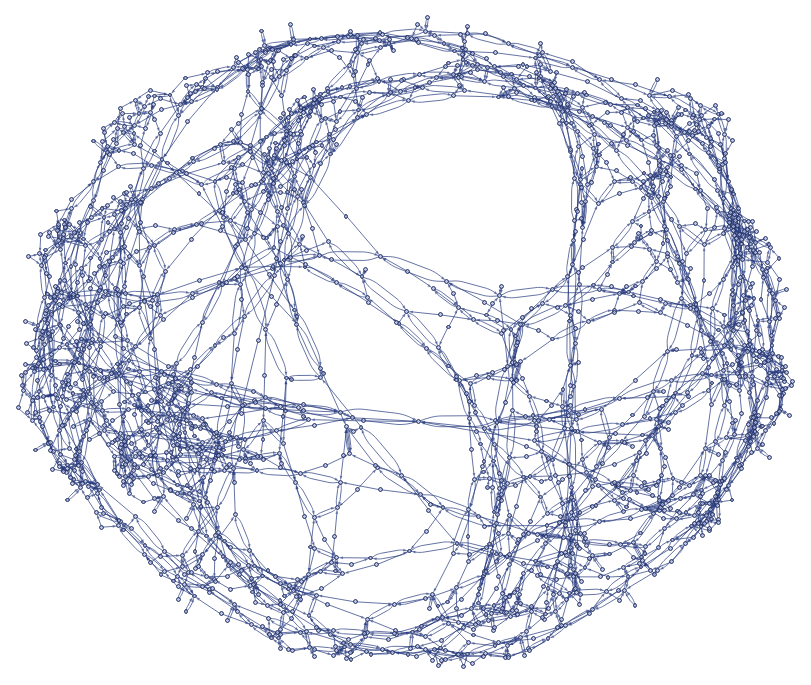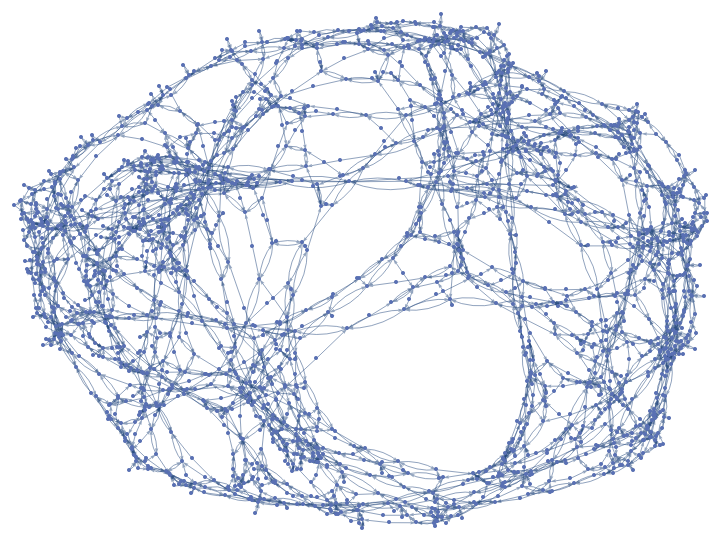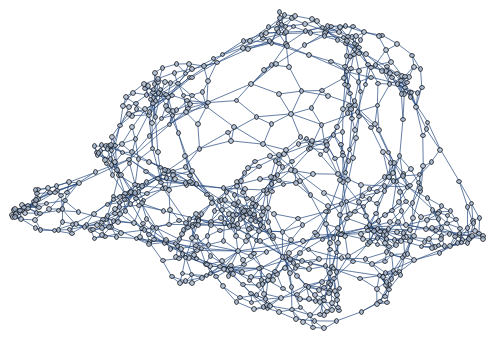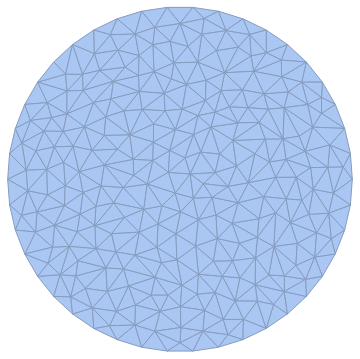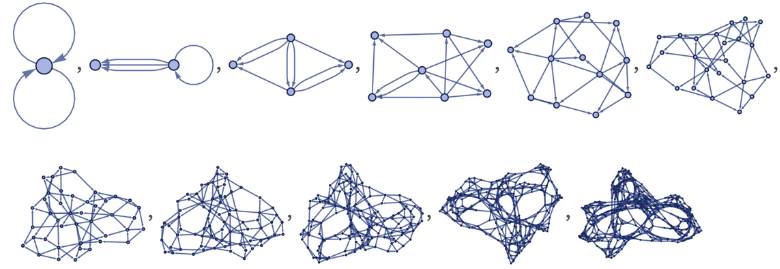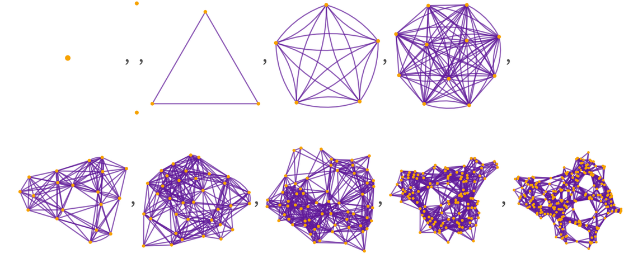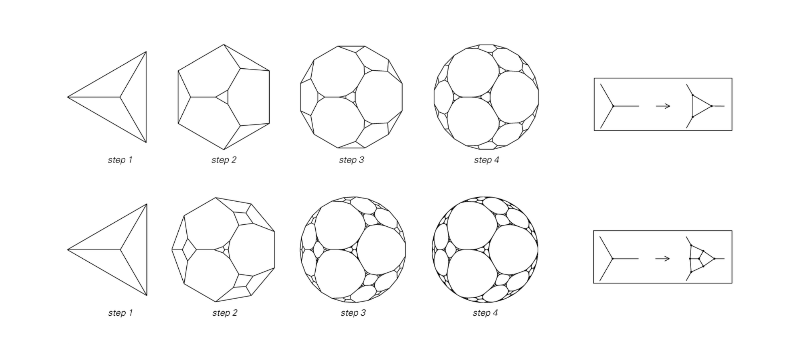In[]:=
ResourceFunction["WolframModel"][{{x,y},{y,z}}->{{x,y},{y,x},{w,x},{w,z}},{{0,0},{0,0}},13,"FinalStatePlot"]
Out[]=
In[]:=
Graph[Rule@@@ResourceFunction["WolframModel"][{{x,y},{y,z}}->{{x,y},{y,x},{w,x},{w,z}},{{0,0},{0,0}},13,"FinalState"]]
Out[]=
In[]:=
baseobj11=Graph[UndirectedEdge@@@ResourceFunction["WolframModel"][{{x,y},{x,z}}->{{x,y},{x,w},{y,w},{z,w}},{{0,0},{0,0}},11,"FinalState"]]
Out[]=
In[]:=
DiscretizeRegion[Disk[]]
Out[]=
First thing to study: spatial hypergraphs
First thing to study: spatial hypergraphs
Local models?
Local models?
Euclidean space
Algebraic varieties (cf tropical algebra)
Algebraic varieties (cf tropical algebra)
What is a hyperfold?
What is a hyperfold?
Limiting object ; analogy: fractals/nested structures are also limiting objects from neighbor independent substitution systems
Random graphs: grown with an algorithm
What is the relevant lowest-level metric?
What is the relevant lowest-level metric?
Definitions
Definitions
[Initially consider an undirected graph]
[Initially consider an undirected graph]
Point
Point
Node in graph
Line
Line
Shortest path between two points [which may not be unique]
or the set of shortest paths between points
Distance between points
Distance between points
Length of shortest path
(To make this a path metric space: we need points, and distances)
[We are implicitly assuming that the distance between adjacent points is 1 unit]
[We are implicitly assuming that the distance between adjacent points is 1 unit]
Path Deviation
Path Deviation
[ This is a test for whether it is “really one path” ] (i.e. in the limit, is it one path or several?)
[ ?? the “number of shortest paths” ]
< Related to injectivity radius >
Going along all geodesics between two points, what is the maximum distance between any two corresponding points?
[[ The following is wrong; 11 should be 10, but then it won’t be interesting ]]
We can imagine some kind of clustering/segregation of different geodesics [trying to see which ones will be distinct in the hyperfold limit]
Tangent space [limiting concept]
Tangent space [limiting concept]
Geodesic ball
Geodesic ball
[Volume (“content”) of the geodesic ball]
[Volume (“content”) of the geodesic ball]
A count of the number of distinct nodes
[ basically this defines measure ]
[ basically this defines measure ]
Geodesic sphere
Geodesic sphere
At least for finite cases, the sphere may not be connected
Triangle
Triangle
Given 3 points A, B, C, draw the geodesics between them
[ special case of a loop ]
[ special case of a loop ]
It is not true that 3 points necessarily define a unique triangle ... because there may be multiple geodesic paths between the points
(On a sphere, 3 points do define a unique triangle, except when two of the points are antipodal)
(Injectivity radius)
(Injectivity radius)
Roughly: how far apart can two points get, while still having a unique geodesic between them?
[In general, will vary with position]
[In general, will vary with position]
[Consider also a fuzzy injectivity radius, where the geodesic isn’t unique, but at least doesn’t get too far apart]
Antipodes
Antipodes
What point(s) are furthest from a given point?
This attempts to find points that are GraphDiameter apart:
We want the antipode of a given point:
Webbed regions
Webbed regions
Given a point and a geodesic not through that point, find the “webbed region” formed by all geodesics from the point to the given geodesic
Geodesic from 50 to 100 [of which there are several], and point 150 [ “geodesic fan” ]
How can we compute (a) area and/or (b) angles? [Related by curvature]
area ; side length ; angle deficit
Interior of region ?
Interior of region ?
Topology
Topology
Boundary
Boundary
Given a collection of points, we can look at all geodesics between pairs of points
Is the whole of a geodesic ball around a point contained in the region? [For unit geodesic balls: for a given point, are all its neighbors in the subgraph?]
[ We need to back off from ordinary topology, because we won’t get nontrivial “ordinary open sets”]
[Can we weaken the set axioms? All only unions of “hopen” sets which have nonzero intersections ... ]
Open set
Open set
Discrete topology: each point is an open set
Functions on the hypergraph
Functions on the hypergraph
Paint a scalar value at every node
Paint a scalar value at every node
E.g. put the distance from a given node as the value at each node
[ Generalized analog of ruler and compass constructibility ]
[ Generalized analog of ruler and compass constructibility ]
We have a “marked ruler” + “marked compass”
Inability to duplicate a cube / trisect an angle
Relativistic analog: the only thing you have are light cones
First level: things that work on a given hypergraph
First level: things that work on a given hypergraph
Next level: things that are somehow correlated in evolving hypergraphs
Next level: things that are somehow correlated in evolving hypergraphs
[ Intermediate? : painting functions on hypergraphs ]
[ Intermediate? : painting functions on hypergraphs ]
